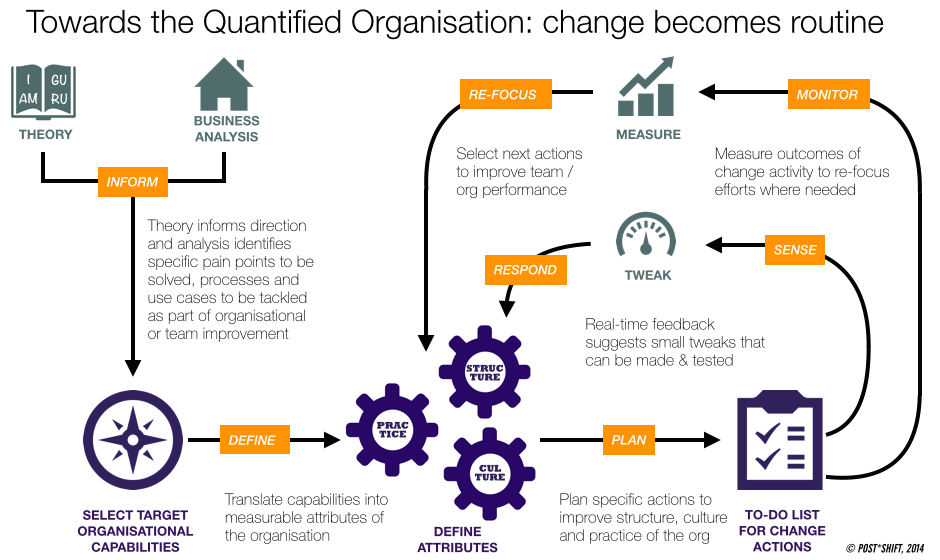One of the challenges we have wrestled with since we launched Post*Shift is how to combine the best elements from new theory, ideas and models in the most practical and actionable way possible, whilst retaining enough flexibility to address the unique features and needs of each part of the organisations we work with. We have always been a very practical team, and have been practising the implementation of new ways of working using social technology since before there were labels like Digital Transformation, Social Business or even E2.0, so we have seen a lot of small things that work and much more that don’t.
It is great to have so many gurus, business books and management frameworks available, and last week’s Drucker Forum in Vienna was another rich source of insights into the ‘why’ and the ‘what’ (if not always the ‘how’) of Twenty-First Century business. There has been such an explosion recently in books and studies about new forms of organisational structure and new approaches to management that even nerds like us can hardly keep up. At every major conference, preachers, teachers and one-model gurus are to be found waving their hands and offering thoughts about the possibility of change in complex organisations. Sometimes we are inspired and excited, and sometimes we sit there quietly sucking our teeth and wondering whether some of these speakers are aware of the painful, complicated, imperfect landscape inside large organisations that makes change so hard to achieve.
What we need from theory
In seeking a consistent approach that can enable company management and internal teams to digest these ideas and turn them into actionable, locally-relevant insights, we have asked ourselves the following questions:
- how can we help organisations navigate the relevant theories and ideas and find the bits that can help them address their own needs?
- how can we translate big ideas into small, everyday actions so that change becomes gradual and accepted?
- how can we evaluate one approach against another if the theories or models start from different assumptions?
In trying to answer these, we have now extended our initial framework of target attributes in both directions to become a solid end-to-end methodology that can translate theory into measurable actions that can be undertaken by various levels of an organisation as part of a gradual, evolutionary approach to digital transformation; or, working in the other direction, it can start with local use cases and needs, helping guide them in the direction of higher-level organisational capabilities they make possible. What excites us about this is that it allows us to create a toolkit and a way of bringing together various small-scale change efforts that can help individual teams and managers to manage change locally, rather than it remain in the realm of top-down initiatives.
Towards the Quantified Organisation: Change becomes Routine
A key problem with organisational change efforts has been this notion of change as an initiative – i.e. a one-off, top-down wave outside the flow of daily work, which might produce short-term improvement, but rarely sustainable impact. Gary Hamel and Michele Zanini articulate this well in their recent McKinsey piece Build a change platform, not a change program. Just as knowledge sharing works better if it is part of the daily flow of work, perhaps change would be more likely to sustain if it too was part of our everyday management of teams and organisations. New behaviours, habits, practices and working culture take time to develop, and they tend to endure only if they are embodied in day-to-day work, not mandated from above.
People are becoming familiar with the idea of Quantified Self – tracking personal health and fitness data to improve wellness – but so far, the idea of Quantified Organisation has only been applied to individual task performance rather than the health and shape of the organisation itself. Just as a crash diet rarely works for individuals to become more healthy compared to gradual QS improvement, which is more effective and sustainable, so big-bang top-down change projects rarely enjoy sustained impact over the long term. Instead of thinking about change as a series of expensive, high-impact projects where a pre-defined model is imposed on a sceptical organisation, we should be monitoring the health and effectiveness of our organisational structures and practices on an ongoing basis, tweaking, iterating and shaping them based on measurement and feedback loops.
One of the great lessons of QS is that if the experience of this data is good enough, and close enough to real-time, then people usually begin to move the needle almost imperceptibly in the right direction without necessarily being conscious of changed behaviour – much like biofeedback in medicine. Our take on the idea of the Quantified Organisation is a framework of organisational health measures, informed by theory and company goals, that can guide ongoing change in an agile, iterative way and assess the success or failure of change actions against the desired future operating state.
Looking through our knowledgebase of theories, methods and ideas, we realised that each can be expressed in terms of required organisational attributes and capabilities, which gives us a way to compare and combine – or mix and match – between models and to evaluate them against each other in specific circumstances. So in our framework, capabilities are first class objects that can be derived from more general goals (‘faster to market’, ‘one face to the customer’ etc) and attributes represent what needs to be in place to achieve them; but also, crucially, they can be either measured or qualitatively assessed. Note that measuring the existence of key capabilities is not the same, in most cases, as existing KPI approaches to assessing outcomes.
Understanding how to achieve these capabilities then helps us enumerate specific, granular recommendations and measure the impact of their implementation over time. These granular recommendations become elements of a to-do list that can be managed, triaged and prioritised on a week-by-week basis in much the same way as agile software development. Think of the goals as agile user stories for the organisation: “We would like to be able to spin up a new team in a day, with everything we need to serve a new customer account”. As Jeff Gothelf wrote in HBR this month, agile as a management principle has huge potential to improve the way organisations work, so it makes sense to organise organisational improvement in the same way.
So, now we have a model that can take a given organisation (or just a department or team), analyse what is wrong or needs to change and, informed both by theory and aspiration, define target capabilities required to improve it; then, we can create a categorised set of recommendations for small actions and changes that can move us forward towards a desired target operating state, whilst measuring progress every step along the way.
Organisational change becomes a weekly agenda item, seeing what works and what can be tweaked, rather than a biennial or triennial major initiative that throws everything up in the air, but ultimately might not achieve traction and change much at all. Importantly, it also gives everybody involved a simple way of assessing what they think needs to change and promoting awareness of the organisational assumptions in which they operate, much as QS has done for the individual. We started with an organisational capability framework of fifteen attributes relating to the main areas of structure, culture and practice, but I would imagine this will change as we refine the model and incorporate additional goals from new theories and models.
What this means for our work
For us, this is exciting, because it means we go into 2015 with an alternative model to traditional strategy consulting or technology implementation as a way to engage with our clients, and crucially one that focuses on how we really add value, rather than trying to shoehorn our work into old ways of bringing external input to a client organisation. This builds on the success of work we have undertaken with clients this year to translate business strategy into digital transformation goals, and then organise the resulting recommended actions in a system that can be dipped into and adjusted as needs change over time.
We can now go further to create a toolkit and a management system for ongoing change actions that puts control in the hands of the individual teams and managers who want to improve their area of operations; but rather than offering a single, fixed methodology, this approach enables people and organisations to assess and assimilate new idea, theories and models that emerge in the future in a way that allows comparison between them and most important of all, consistent measurement of progress and results. Our goal is to enable individual teams, managers and change agents inside organisations to do this work themselves, rather than wait for a combination of executive edict and external consultants to do it for them.


